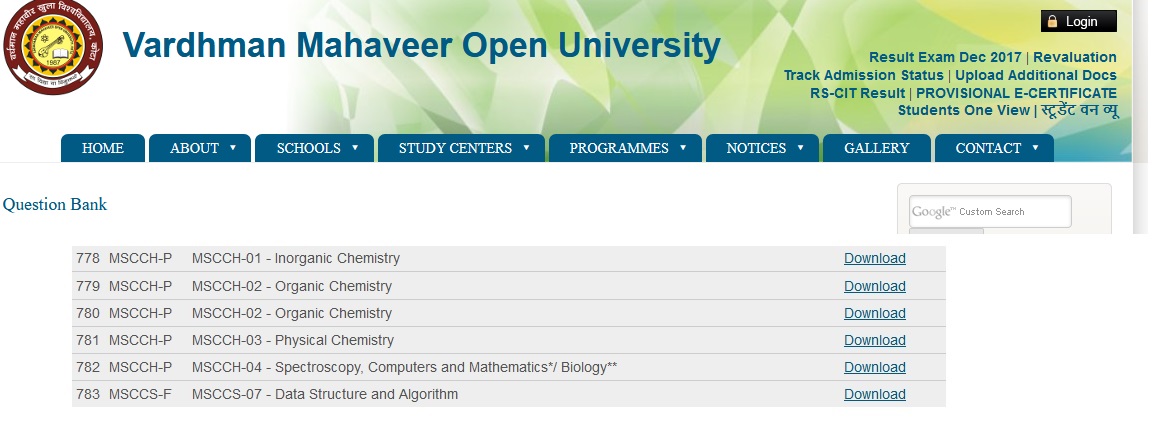MSCCH01 Inorganic Chemistry M.Sc Question Bank : vmou.ac.in
Name of the University : Vardhman Mahaveer Open University
Degree : M.Sc
Department : Chemistry
Subject Code/Name : MSCCH-01 – Inorganic Chemistry
Year : I
Document Type : Question Bank
Website : vmou.ac.in
Download Model/Sample Question Paper : https://www.pdfquestion.in/uploads/vmou.ac.in/3711-MSCCH-01_131.pdf
VMOU Inorganic Chemistry Question Paper
Very Short Answer Type Question :
Section – A
1. What type of bonding is present between metal and ligand-
Related : VMOU MSCCH09 Drugs and Pharmaceuticals M.Sc Question Bank : www.pdfquestion.in/3708.html
2. How we designate the five d-orbitals-
3. How we denote the energy gap between sets of orbitals-
4. What is the relation between –
5. What is the John-Teller effect-
6. Gives the example of weak and strong ligands.
7. What is the No distortion cases of octahedral geometries-
8. What is the relation between paring energy (P) and –
9. Who gives the MOT-
10. What is the meaning of LCAO-

11. What is the symmetry label for S and P orbitals-
12. What is the meaning of Node-
13. What is the formula of number of microstates possible –
14. Calculate the number of microstates-
15. What is the procedure to obtain the “Term”-
16. What is the representation of Term-
17. What is the meaning of –
18. What is the rule for electronic transition according to spin selection –
19. When we use the orgel diagrams-
20. What kind of transition-
21. What we can use to check the thermodynamic stability –
22. What is the classification of metal complexes-
23. What is the classification of metal complexes-
Section – B
Short Answer Type Question :
1. What is a symmetry operations- How much type of symmetry –
2. How can you define the plane of symmetry –
3. Take one example of a molecule and show the presence of Identity element.
4. What is the application of product rule in case of symmetry-
5. Explain the inverse of – and – axis for all values of n and m.
6. Determine the point group of the following :
7. Determine the point of planar and pyramidal molecules
8. Explain the systematic classification of molecules into point groups.
9. Show that the number of classes is always lesser than –
10. Explain the similarity transforms of each of the three –
11. What is the relation between molecular polarity and symmetry-
12. What are the limitations of crystal field theory-
13. Discuss the crystal field splitting in octahedral complexes.
14. Explain the splitting of d-orbital according the crystal field theory –
15. What is CFSE- Calculate the value of CFSE in the form of Dq-
16. Discuss various factors affecting the crystal field splitting energy –
17. Write short note on spectrochemical series-
18. Write the basic postulates of molecular orbital theory.
19. Explain the formation of composite ligand orbitals for –
20. Construct the molecular orbital diagram for tetrahedral –
21. Explain briefly L-S coupling-
22. Explain hole formulation-
23. How the spectroscopic ground state is determined-
24. What is meant by the terms 3- 3 and 1- 1- Explain.
25. What is Laporte orbital selection rule-
26. What is meant by spin selection rule?
27. Under which circumstances the relaxation in Laporte selection rule is given.
28. Write a short note on Labile and inert complexes.
29. Describe the kinetic and thermodynamic stability of complex compounds.
30. Draw and explain the energy profiles diagram of a catalyzed and un catalyzed reaction?
31. What is the acid hydrolysis in case of substitution reactions of octahedral complexes?
32. What is effect of chelation on the rate of hydrolyses of octahedral complexes?
33. Discuss the mechanism as per Langford-Gray for the substitution reactions of octahedral complexes.
34. Discuss the Trans-effect with suitable examples.
35. Illstrate the use of trans-effect in the synthesis of given isomer complex.
36. What is trans effect? How does it affect the substitution of square planar complexes?
37. Discuss the mechanism of outer sphere electron-transfer reactions.
38. What do you understand by chemical activation and electron transfer?
39. Explain the role of bridging ligand in inner-sphere mechanism with suitable examples.
40. Explain all the features of an oxidative addition reaction with a specific example of a complex.
41. What s the Ziegler-Natta catalyst? How it is used in polymerization reaction?
42. Give the characteristic features of hard and soft acids.
43. Discuss the effect of chelation on the stability of complexes.
44. How it is possible to determine the stability constant of a metal complex by PH metric method.
45. What is the principle involved in spectrophotometric method of determining stability constant of a metal complex?
46. Draw the molecular orbital diagram of CO and explain its features.
47. CO is both a 𝜎- donor and 𝑐acceptor Explain.
48. How much types of bonding modes of Nitric oxide to metals if possible?
49. Define metal cluster. How much type of structural bonding is possible in case of iron carbonyl clusters.
50. Explain the factor that favour cluster formation.
How can we designate the five d-orbitals?